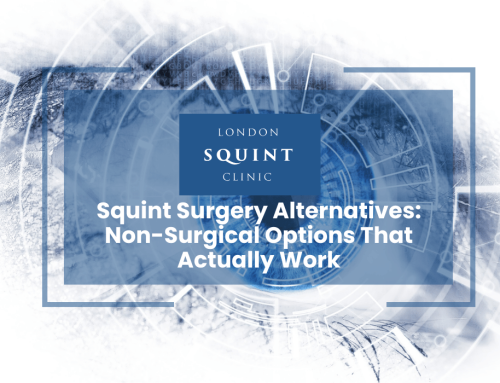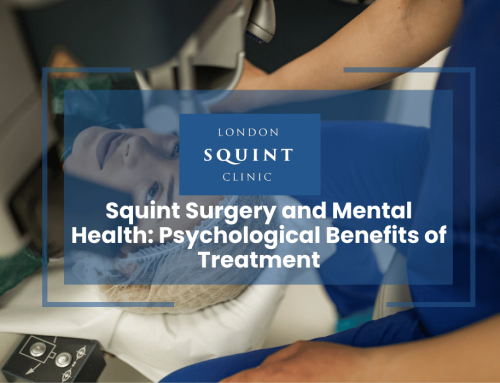Age-Related Eye Muscle Changes: Double Vision in Older Adults
Age-Related Eye Muscle Changes
- Age-related double vision (diplopia) is not a normal part of aging and should be evaluated by a healthcare professional
- Double vision in older adults often results from weakening eye muscles, deteriorating connective tissues, and neurological changes
- Common symptoms include seeing two images, eye strain, headaches, and difficulty with depth perception
- Diagnosis involves comprehensive eye examinations, alignment tests, and sometimes advanced imaging
- Treatment options range from prism lenses and vision therapy to Botox injections and surgery in severe cases
- Preventive measures include regular eye exams, eye exercises, proper nutrition, and managing underlying health conditions
- Seek immediate medical attention for sudden-onset double vision, especially when accompanied by headache, weakness, or other neurological symptoms
Table of Contents
- Understanding Age-Related Double Vision: Causes and Mechanisms
- How Aging Affects Eye Muscles and Vision Coordination
- Common Symptoms of Diplopia in Elderly Patients
- Why Do Older Adults Experience Double Vision More Frequently?
- Diagnosing Age-Related Double Vision: Tests and Procedures
- Treatment Options for Elderly Patients with Diplopia
- Preventing and Managing Double Vision as You Age
- When to Seek Medical Help for Age-Related Vision Changes
How Aging Affects Eye Muscles and Vision Coordination
The aging process brings about significant changes to our eye muscles and the complex system that coordinates vision. The six extraocular muscles controlling each eye’s movement naturally lose some of their strength and elasticity over time, similar to how other muscles in our body change with age. This weakening can lead to subtle misalignments between the eyes that weren’t present in younger years.
Additionally, the connective tissues supporting these muscles undergo age-related changes. Ligaments and tendons become less flexible, and the fascial structures surrounding the eye orbit may lose some of their supportive function. These changes can affect the precise alignment needed for perfect binocular vision.
The neuromuscular junction—where nerve signals instruct eye muscles to move—also experiences age-related deterioration. This can result in less efficient communication between the brain and eye muscles, potentially causing delays or inaccuracies in eye movement coordination.
Another significant factor is the development of presbyopia, the age-related loss of lens flexibility that affects near vision. As presbyopia progresses, it can create additional strain on the visual system, sometimes contributing to convergence insufficiency—a condition where the eyes struggle to turn inward properly when focusing on near objects.
These physiological changes don’t occur in isolation. They interact with other age-related conditions such as cataracts, macular degeneration, and systemic health issues like diabetes or hypertension, which can further compromise the delicate balance required for single, clear vision.
Common Symptoms of Diplopia in Elderly Patients
Elderly patients experiencing age-related double vision often present with a constellation of symptoms that can significantly impact their daily functioning. The most obvious symptom is seeing two images of a single object, which may appear side by side (horizontal diplopia), one above the other (vertical diplopia), or with one image tilted relative to the other (torsional diplopia).
Many seniors report that their double vision worsens with fatigue, particularly toward the end of the day. This pattern occurs because the eye muscles and coordination systems become increasingly strained after hours of visual work. Some patients may notice that their symptoms are more pronounced when looking in specific directions or at certain distances.
Beyond the visual doubling itself, elderly patients with diplopia commonly experience:
- Eye strain and fatigue, especially after reading or using digital devices
- Headaches, particularly around the eyes or forehead
- Difficulty with depth perception, leading to challenges with tasks like pouring liquids or navigating stairs
- Increased sensitivity to bright lights
- Difficulty maintaining focus while reading
- Discomfort or nausea when trying to focus on moving objects
- Tendency to close or cover one eye to eliminate the double image
- Anxiety about activities requiring precise vision, such as driving
Many elderly patients also report a gradual adaptation to their symptoms, sometimes unconsciously tilting their head or adopting other compensatory postures to align their vision. These adaptations, while helpful in the short term, can lead to secondary issues such as neck strain or balance problems.
Why Do Older Adults Experience Double Vision More Frequently?
The increased prevalence of double vision among older adults stems from multiple age-related factors that collectively compromise the visual system’s ability to maintain perfect binocular alignment. As we age, the cumulative effect of these changes significantly raises the risk of developing diplopia.
One primary factor is the natural degeneration of orbital tissues. The fatty cushion that supports the eyeball within the orbit often atrophies with age, potentially allowing subtle shifts in eye position. Similarly, the connective tissues that anchor the extraocular muscles may lose some of their structural integrity, affecting the precise tension needed for perfect eye alignment.
Age-related neurological changes also play a crucial role. The brain’s ability to fuse slightly misaligned images—a process called fusion—may become less efficient with age. This reduced neural plasticity means that minor misalignments that would have been compensated for in younger years now manifest as double vision.
The prevalence of systemic health conditions that affect vision also increases with age. Conditions such as diabetes, hypertension, and atherosclerosis can compromise blood flow to the eyes and their controlling structures. Squint surgeons often identify these underlying health issues as contributing factors to late-onset diplopia.
Additionally, older adults are more likely to have experienced cumulative effects of previous eye conditions, surgeries, or injuries that may have subtly altered eye alignment. Even minor misalignments that were previously well-compensated can become symptomatic as the visual system’s compensatory mechanisms decline with age.
Medication side effects represent another significant factor. Many elderly patients take multiple medications, some of which can affect extraocular muscle function or neurological control of vision, potentially triggering or exacerbating double vision.
Diagnosing Age-Related Double Vision: Tests and Procedures
Accurate diagnosis of age-related double vision requires a comprehensive approach that identifies both the specific type of diplopia and its underlying causes. The diagnostic journey typically begins with a detailed medical history, focusing on when symptoms began, whether they’re constant or intermittent, and if they’re associated with particular activities or times of day.
Visual acuity testing forms the foundation of the examination, assessing how well each eye can see individually and together. This is followed by a thorough assessment of ocular alignment using various tests:
- Cover tests, where one eye is covered while observing movement in the uncovered eye
- Prism tests to measure the precise angle of misalignment
- Versions and ductions tests to evaluate the movement of each eye in different directions
- Maddox rod testing to assess subtle vertical misalignments
- Hess screen or Lancaster red-green tests to map eye muscle function comprehensively
Specialists also evaluate the health of the eye muscles and their controlling nerves through careful examination of pupil responses, eyelid position, and orbital structures. Advanced imaging may be necessary in some cases, including:
- MRI or CT scans to visualise the extraocular muscles, orbital structures, and brain areas involved in vision
- Ultrasound to examine the eye and surrounding tissues
- Blood tests to identify systemic conditions that might contribute to diplopia
For elderly patients, the diagnostic process often includes assessment of other age-related vision changes such as cataracts or macular degeneration, which may coexist with or complicate diplopia. Careful attention is also paid to medication reviews, as certain pharmaceuticals commonly prescribed to older adults can affect eye muscle function.
Treatment Options for Elderly Patients with Diplopia
Treatment approaches for age-related double vision are tailored to the specific cause, severity, and the patient’s overall health status. For elderly patients, management typically follows a stepwise approach, beginning with the least invasive options.
Optical corrections often serve as the first line of treatment. These may include:
- Prescription glasses with prism lenses that bend light to compensate for eye misalignment
- Fresnel press-on prisms as a temporary solution or for patients whose alignment varies
- Specialised lens designs that address both diplopia and presbyopia simultaneously
Non-surgical interventions can be highly effective for many elderly patients:
- Vision therapy exercises to strengthen eye muscle coordination and improve fusion ability
- Orthoptic exercises specifically designed to address convergence insufficiency
- Occlusion therapy (patching) for intermittent symptoms or as a temporary measure
- Botulinum toxin (Botox) injections to temporarily weaken overactive eye muscles, particularly useful for patients who may not be suitable candidates for surgery
For persistent diplopia that significantly impacts quality of life, surgical intervention may be recommended:
- Strabismus surgery to adjust the tension of the extraocular muscles
- Adjustable suture techniques that allow fine-tuning of alignment after surgery
- Mini-tenotomy procedures that can be performed under local anaesthesia for elderly patients with health concerns
Management of underlying medical conditions is equally important. Treating conditions like diabetes, thyroid dysfunction, or hypertension can sometimes improve diplopia symptoms. Medication adjustments may be necessary if current prescriptions are contributing to the problem.
For elderly patients with permanent diplopia that cannot be fully corrected, adaptive strategies such as monocular occlusion for specific activities or visual aids for reading and close work may significantly improve daily functioning and independence.
Preventing and Managing Double Vision as You Age
While not all age-related changes to vision can be prevented, several proactive strategies can help maintain eye muscle health and potentially reduce the risk or severity of diplopia as you age. A comprehensive approach to prevention and management includes both lifestyle modifications and regular healthcare practices.
Maintaining overall eye health forms the foundation of prevention:
- Regular comprehensive eye examinations, ideally annually for those over 60
- Prompt attention to any changes in vision, even subtle ones
- Proper management of conditions like diabetes and hypertension that can affect eye health
- Protection from UV exposure with quality sunglasses
- Maintaining proper lighting for reading and close work to reduce eye strain
Specific exercises can help maintain eye muscle strength and coordination:
- Convergence exercises to strengthen the ability of eyes to turn inward for near vision
- Focus shifting between near and distant objects to maintain accommodation flexibility
- Tracking exercises that follow moving objects to maintain smooth pursuit movements
- Computer vision syndrome prevention techniques, including the 20-20-20 rule (every 20 minutes, look at something 20 feet away for 20 seconds)
Nutritional support for eye health becomes increasingly important with age:
- Adequate intake of antioxidants, particularly lutein and zeaxanthin
- Omega-3 fatty acids for overall eye health
- Sufficient vitamin A, C, and E consumption
- Proper hydration to maintain optimal tear film quality
For those already experiencing mild symptoms, management strategies might include:
- Taking regular breaks during visually demanding tasks
- Adjusting computer screens and reading material to optimal positions
- Using good posture to maintain proper alignment between eyes and visual targets
- Considering reading glasses or multifocals specifically designed to reduce eye strain
Early intervention at the first signs of diplopia is crucial, as addressing minor misalignments can often prevent progression to more severe double vision that impacts daily functioning.
When to Seek Medical Help for Age-Related Vision Changes
While some vision changes are a normal part of aging, double vision is never considered a normal age-related change and warrants prompt medical attention. Understanding when to seek help can prevent complications and ensure timely treatment for potentially serious underlying conditions.
Seek immediate medical attention if double vision:
- Develops suddenly or appears without warning
- Is accompanied by severe headache, facial numbness, or weakness in any part of the body
- Occurs following head trauma, even if seemingly minor
- Is associated with pain in or around the eye
- Comes with noticeable drooping of the eyelid or changes in pupil size
- Is accompanied by difficulty speaking, confusion, or coordination problems
These symptoms could indicate serious conditions requiring emergency care, such as stroke, aneurysm, or increased intracranial pressure.
Schedule a prompt (non-emergency) appointment if you experience:
- Gradual onset of double vision that persists for more than a few days
- Double vision that comes and goes but is becoming more frequent
- Vision doubling that worsens with fatigue or at specific times of day
- New difficulty with depth perception or coordination
- Double vision limited to specific directions of gaze
- Visual changes following recent illness or starting new medication
When consulting healthcare providers about double vision, it’s helpful to note specific details about your symptoms:
- When the double vision began and how it has progressed
- Whether images appear side-by-side, one above the other, or overlapping
Frequently Asked Questions
Is double vision a normal part of aging?
No, double vision (diplopia) is never considered a normal part of aging. While some vision changes like presbyopia (difficulty focusing on near objects) are expected with age, seeing double is always a symptom that requires medical evaluation. It often indicates an underlying issue with eye muscle coordination, neurological function, or other health conditions that can be diagnosed and treated.
What is the most common cause of double vision in elderly people?
The most common cause of double vision in elderly individuals is age-related weakening of the extraocular muscles that control eye movement. Other frequent causes include cranial nerve palsies (particularly involving the 3rd, 4th, or 6th cranial nerves), age-related changes to orbital tissues, vascular conditions like diabetes or hypertension affecting blood supply to the eyes, and neurological conditions affecting vision coordination centers in the brain.
How is age-related double vision different from other types of diplopia?
Age-related double vision typically develops gradually over time, while other forms of diplopia often appear suddenly. Age-related diplopia is frequently associated with deterioration of eye muscles and supporting structures, tends to worsen with fatigue, and may fluctuate throughout the day. It’s also more likely to be accompanied by other age-related vision changes and is often binocular (present when both eyes are open) rather than monocular (present when only one eye is open).
Can double vision in older adults be cured?
Many cases of double vision in older adults can be successfully treated or managed, though “cure” depends on the underlying cause. Treatment options include prescription glasses with prism correction, vision therapy exercises, Botox injections to realign eye muscles, or surgery in some cases. When double vision results from an underlying health condition like diabetes or thyroid disease, treating the primary condition often improves visual symptoms as well.
What exercises can help with age-related double vision?
Several exercises can help strengthen eye muscles and improve coordination for age-related double vision:
1. Pencil push-ups: Hold a pencil at arm’s length, slowly bring it toward your nose while maintaining single vision
2. Brock string exercises: Focus on beads placed at different distances on a string
3. Convergence exercises: Practice focusing on near objects while maintaining single vision
4. Tracking exercises: Follow moving objects horizontally and vertically without moving your head
5. Focus shifting: Alternate focus between near and distant objects
These exercises should be performed under the guidance of an eye care professional for best results.How do prism glasses help with double vision?
Prism glasses help with double vision by bending light before it enters the eye, effectively realigning the images seen by each eye. The prism shifts the image to compensate for eye misalignment, allowing the brain to fuse the two images into a single, clear picture. Prisms can be ground into regular prescription lenses or applied as temporary Fresnel press-on prisms. They’re particularly effective for stable, measurable misalignments and often provide immediate relief from diplopia symptoms.
When should elderly patients with double vision avoid driving?
Elderly patients with double vision should avoid driving when:
1. The double vision is constant and not corrected by glasses or other treatments
2. Symptoms worsen with fatigue or at night
3. The condition affects depth perception or peripheral vision
4. They experience associated symptoms like dizziness or disorientation
5. Their eye care professional or physician has specifically advised against driving
Safety should always be the priority, and alternative transportation arrangements should be made until the condition is properly managed or resolved.
Find out if you are suitable for Double Vision Treatment
Not everyone is eligible for double vision surgery.
Find out if you could benefit from this life-changing surgery by taking the quick self-suitability quiz below:
Our most popular procedures

Hello, I’m Nadeem Ali
I’m one of the few eye surgeons in the world with 100% focus on Squint and Double Vision Surgery.
I have 24 years of eye surgery experience, and worked for 13 years as a Consultant at London’s renowned Moorfields Eye Hospital.
In 2023, I left the NHS to focus fully on treating patients from across the world at the London Squint Clinic. You can read more about me here.
There’s lots of information on the website about: squint surgery, double vision surgery and our pricing.
The most rewarding part of my job is hearing patients tell me how squint or double vision surgery has changed their lives. You can hear these stories here.
Mr Nadeem Ali
MA MB BChir MRCOphth FRCSEd(Ophth)





